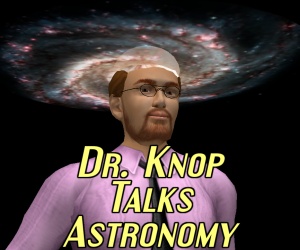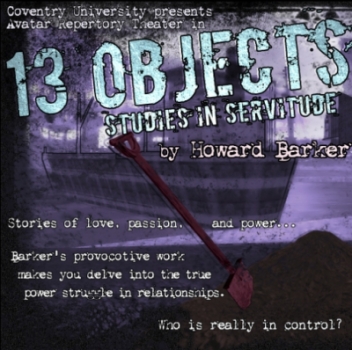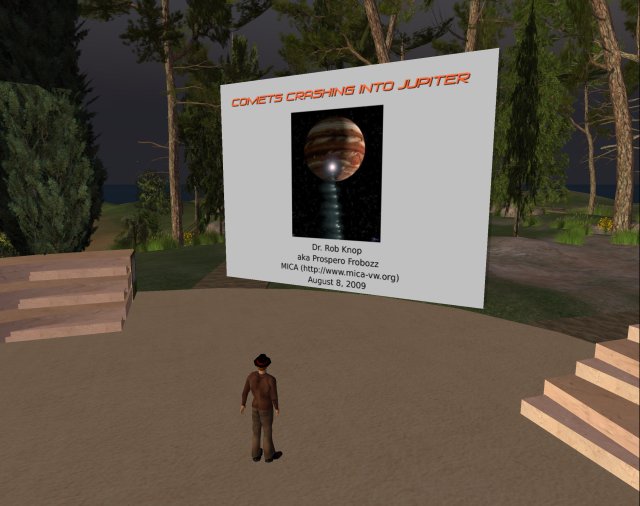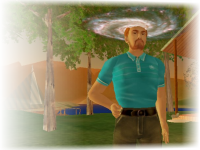Second Life’s greatest asset, and how it was squandered
Posted on June 13th, 2010 — permalink
Before I start, I should note that I haven’t worked for Linden Lab for more than a year now, so I’m not giving away any inside information, nor do I have any inside information. Yes, my opinions are formed partially by what I learned while I was inside Linden, but I’m writing this based on my observation as an interested outsider.
I think often the way to kill a business is to over-monetize it. I remember the 1990’s, and Web search engines. The pattern was repeated over and over again. There’d be one that was the best. They’d realize they were the best, and they’d either get sold or they’d try to monetize their business. The page would go from being relatively clean, to being a cluttered mess of ads… and the search results, being increasingly paid, would become less and less useful. So we’d all move on to another engine. That ended with Google, who had the vision not to try too soon to over-monetize their search, and who recognized when they did monetize it that they had to do it in a way that didn’t completely undermine what brought people there in the first place. If you’re doing something new and cool, you’re better off focusing on how to make it cooler than you are focusing on how to squeeze a buck out of it.
How does this apply to Linden? Many think that Linden’s best asset is their technology. It’s not. Don’t get me wrong, the technology is good; but it can be replicated. Server side, OpenSim is already well on its way to replicating (and in some ways exceeding) the server side technology of Second Life. Client side, the Second Life client is still way ahead of anything out there that’s not based on the GPL Second Life client source, but that won’t last forever; after all, there are lots of MMO clients out there, so it can be done! No, Linden’s greatest asset is its audience.
I know Philip got this. Talking to the company while I was still there (a year before I left? I don’t remember) about OpenSim and competition in general, he said that OpenSim and interoperability would only be positive for Second Life. After all, Second Life had the greatest number of residents. Even if that didn’t stay, a growing interest in and a growing usefulness of virtual worlds would only help Second Life. Alas, the company as a whole didn’t realize this. What they should have been focusing on was promoting virtual worlds. Instead, they… well, to be honest, I’m not really sure what they were focusing on, but they didn’t direct substantial effort towards promoting virtual worlds in general. And that was the mistake that, I believe, led to the massive June 9 layoffs, or what I call “Lindenmageddon”.
In 2008, a team of engineers from Second Life working together with a team from OpenSim premiered a bold and exciting experiment. From the beta grid (Aditi), users were able to take their Second Life accounts and teleport to regions running the OpenSim server. The functionality was extremely basic, but it was a concept demonstration. This was the first step to interoperability. I was only peripherally involved in this myself. As a member of the server release team (perhaps server release manager by then?), I helped the engineers working on this get some regions set up, and would warn Whump whenever we were going to do things to aditi that might interupt his operations. (I also annoyed Whump a few times when doing things on the beta grid without giving him enough warning….) But, when the experiments were happening, I joined in with other Lindens and residents to see what all the fuss was. I felt like I was walking on the moon. I remember commenting to others that we were exploring grand new worlds, taking the first (and very limited) step in what was going to be a gigantic new thing. People outside the lab were talking about the possibility of true interoperability in the main grid (the production Second Life environment) during 2009. It was all very exciting. Second Life was bursting out of its shell, and was finally providing the seed for the true global metaverse that it had always promised that it could turn into.
Alas, after that, the interoperability work coming out of Linden Lab slowed to a trickle. It didn’t stop, but outside nobody else saw anything new. Many of the engineers working on it were redirected to work on the (now defunct) “Second Life Enterprise” product. (I always personally thought that was a dead-end, but I was careful who I said that too. I was annoyed that some release people we needed for other things had time taken away working on it, and I was sad that the manager whom I loved, Josh Linden, got pulled over to it. But I was also sad to see the company working on the 3D version of Novell Networks instead of the 3D version of the Internet.) Yes, Linden still did things; Enus, at least, was working on the PyOGP stack, and Zero and Infinity were involved in standards meeting and developing the WVRAP protocol. (Incidentally, Infinity left Linden Lab a month ago, and Zero was part of the June 9 Lindenmageddon layoffs.) But there was no big effort. Out of this lack of more public progress from Linden was born Hypergrid, Crista Lopes’ working interoperability protocol between separate OpenSim grids. Hypergrid still has some things it’s lacking, but it got much farther than any implementation out of Linden.
And now concurrency (number of people online at one time) in Second Life has been sagging, and the lack of growth has caused financial distress for the lab. (I don’t have inside figures, but Tateru Nino figured out at least this much from looking at the public figures.) Yes, it’s a recession. But Linden made the mistake of having people in control who were business types, who think in terms of consumers and monetization. They didn’t get Second Life. (Truthfully, nobody does, and the first step to understanding virtual worlds is recognizing that you don’t get it. It’s a tremendously flexible potential platform. Like the Web, if you try to put it in a conceptual silo and productize it, you’re going to be making something like early 1990’s walled-garden AOL, which will fail in the face of the true Web.)
I work with MICA, the Meta-Institute of Computational Astronomy. We maintain a presence in Second Life, even though really we’d rather be working on open source servers that we control ourselves– i.e. OpenSim. There are two main reasons why we stay with Second Life. The first is that OpenSim doesn’t yet have a good Voice solution… but that will change. The second is that Second Life is where everybody is. The popular talks that I and some others give wouldn’t make sense anywhere else, because the audience isn’t there. And this is what Second Life’s greatest asset is.
If Linden Lab had focused on helping make virtual worlds take off– make them more useful by providing functionality people wanted and needed, working on interoperability so that people could take their Second Life accounts to and from software that was developed not only by Linden engineers, but by everybody– I predict they would have done a whole lot better. Their already existing audience would have given them a leg up, and would have kept them a leader or at least a major player. Yes, they would have been helping “competitors”, but by raising the profile, utility, and popularity of virtual worlds in general, they would have helped themselves.
I predict that the decline of Linden will set back the adoption of virtual worlds several years. And that may not be so bad. After all, before the Web, there was Gopher, which was never all that big. Before that, there was CompuServe, a walled garden that a lot of people used, but which became increasingly irrelevant as there was the Web. Second Life had the opportunity to be the seed for the 3D web, but instead they chose to focus on being the 3D CompuServe. As we go into the future, OpenSim, or another platform that defines its protocols, provides a working reference implementation, and supports true interoperability will form the basis of the true global metaverse. And, once we have that, and once people are able to develop cool things to run on top of it as flexibly as possible (i.e. not limited to just LSL and renting space on Linden’s servers), we’ll see the metaverse take off. As to whether or not Second Life is part of that, we can only wait and watch. It will take more vision than trying to somehow connect to current hot buzzwords (”social media”) if they really want to be a part of this. And even if they are, they may not be a meaningful part. (After all, AOL is still a part of the Internet, is it not? But with the possible exception of the AIM protocol, they aren’t a meaningful part.)
32 Comments
Posted in Linden Lab, Second Life, Second Life Technology |
Internet Astrophysics Celebs Carroll & Gay to Speak in Second Life
Posted on February 4th, 2010 — permalink
For those of you who haven’t been following my blog or watching my twitter or facebook updates, you may not realize that there are regular public-outreach astronomy talks in Second Life. These are designed for the general public, and are open to anybody. Indeed, because a Second Life account is free, they really are open to anybody. These talks are on Saturdays at 10 AM pacific time / 1 PM eastern time, are sponsored by the Meta-Institute of Computational Astrophysics, and are held in MICA Large Amphitheater of the StellaNova region in Second Life.
This series has historically been called “Dr. Knop Talks Astronomy”, because through the end of 2009 I have given the lion’s share of the talks. Indeed, I was thinking about it the other day. The last semester before I left Vanderbilt, I was contacted by the people who make the CD series called “The Great Courses”. These are CDs with lectures from university professors on their topics of expertise. Based on some podcasts of mine that were online from several years ago, they contacted me and asked me to come audition. The idea was that if I passed it, they might well produce a course from me. However, when I left Vanderbilt, and could no longer call myself a “Professor of Physics and Astronomy”, they were no longer interested in me.
It occurs to me that given the number of talks I’ve presented so far, those who have come to most or all of my talks have effective received the equivalent of one of these CD series on “hot topics in astronomy.” Indeed, it was more than that, for not only were there visuals (i.e. my slides), but it was interactive. You could ask questions, and also discuss the talk with the others present.
If you look at our schedule for this coming semester, you’ll see that we’re starting to mix things up some more. I’m still giving more of the talks than any other single person, but we’ve got a larger range of guest speakers. You can see who’s coming up soon by looking at the Upcoming Public Events page.
Last week, we had Nobel Prize winner John Mather speaking about the history of the whole Universe, and of hopes and plans for the upcoming Webb Space Telescope. In the next two weeks, we’ll have two “Internet Celebrities” talking. Sean Carroll, one of the authors of the popular physics blog Cosmic Variance, will be talking about his recently released book on the nature of time, From Eternity to Here. Then, Pamela Gay, host of 365 Days of Astronomy and a member of Astronomy Cast, will be speaking in two weeks.
Drop by and hear us. These talks can be very good… and, while you shouldn’t believe me if I tell you my own talks are good, others have told me that they are. The immersive environment of virtual worlds means that you really feel you are there— John Mather was commenting on this just last week after giving his talk.
Comments Off
Posted in Physics & Astronomy, Science, Second Life, Second Life Events |
AAS Astronomy Events Live Streamed into Second Life
Posted on January 4th, 2010 — permalink
I’m at the annual big meeting of the American Astronomical Society this week in Washington, DC. Lots of stuff going on, and I’m already overwhelmed by the sheer number of people here. (And, also, depressed by the number of young people here in comparison to the number of entries on this list.
Several of the bigger events— press conferences, invited talks— are going to be live streamed into Second Life. Drop by the Astronomy 2009 island to hear the talks, including the Wednesday at 8AM Eastern / 5AM Pacific talk by astronaut and Hubble Mechanic John Grunsfeld. These events are hosted by Astronomy 2009 and by the Astrosphere New Media (Pamela Gay’s and others’ new venture). A full schedule is here.
Remember that a Second Life account is free! Drop by and check it out. And, once you’ve got a Second Life account, nothing will be stopping you from coming to hear my public astronomy talks that I frequently give.
1 Comment
Posted in Physics & Astronomy, Science, Second Life, Second Life Events |
“Dr. Knop Talks Astronomy” — archived on the web
Posted on December 15th, 2009 — permalink
 I give regular talks in a series entitled “Dr. Knop Talks Astronomy” as part of MICA’s public events. These talks are in Second Life, so people from all over the place can come to them.
I give regular talks in a series entitled “Dr. Knop Talks Astronomy” as part of MICA’s public events. These talks are in Second Life, so people from all over the place can come to them.
if you’ve missed them, and want to catch up on them, at the site above slides from most of my talks are archived, as well as MP3 files of the audio in many cases. However, there are now three of the talks online that have been recorded fully in video. Of course, it’s not the same as being there, since you can’t ask questions and interact, but it might give you a sense of what goes on at these things.
The first one is a talk about how we know that Dark Matter exists that I gave several months ago; this talk is online at PookyMedia.
More recently, Geo Meek has recorded my most two recent talks, and there is now a Dr. Knop Talks Astronomy channel at livestream. The two talks online there are one all about redshift (the Doppler shift, gravitational redshift, cosmological redshift), and my talk a few days ago about black hole misconceptions. Special thanks to Spike McPhee (aka Paradox Olbers) for supporting this latter effort!
Joe Bob Says Check It Out!
(Update: it looks like the black hole talk is not online at livestream yet, as of 2009-12-15 13:40. However, I believe it will be before too long.)
Comments Off
Posted in Cosmology, Physics & Astronomy, Science, Second Life, Second Life Events |
The REAL Christmas Story— ART Production Dec 11-13
Posted on December 10th, 2009 — permalink
Come by and see Avatar Repertory Theater’s 2009 Christmas production, entitled The REAL Christmas Story. This production includes three short plays written by members of the troupe.

In The Christmas I Met Santa, we find out how one Christmas changed everything for one little boy. In that show, I have a non-speaking role, and others have lines… but I say more than anybody with lines. How can this be? Come and find out! In He Remembers It Well, a reporter sent on a banal Christmas assignment finds out that even the silliest of assignments can be quite interesting. In And It Was Christmas Day, YADF (Your Average Dysfunctional Family) provides the sort of catharsis you need in order to face your own family during the holidays….
The productions will be in Second Life at the George C. Dove Theater in Rockcliffe University’s region. Productions are on Friday at 5pm PST, Saturday at 3pm PST, and Sunday at 2pm PST. Remember that a Second Life account is free!
Comments Off
Posted in Second Life, Second Life Events |
Howard Barker’s 13 Objects — global performance October 20 and 21
Posted on October 15th, 2009 — permalink

Howard Barker is a celebrated British playwright. On October 21st, there will be an international celebration of his works entitled 21 for 21. Participating in this celebration will be Avatar Repertory Theater, the virtual theater company of which I am a part. We’ll be putting up a production of his play 13 Objects: Studies in Servitude.
This is one of those things that makes it very clear that virtual worlds are not just computer games. These 13 short plays are all interesting and challenging, and vary all over the place in tone. Some of them are funny, some of them are grim, some of them are surreal, and all of them give you various different things to think about. It’s being directed by Joff Chafer, a faculty member at Coventry University. The cast is a sundry group of people from all of the USA, the UK, Austrailia, and New Zealand. It includes at least three former professors (two of whom were English professors, one of whom was perversely a professor of physics & astronomy…), a former Opera singer, and a couple of people who have performed and continue to perform professional theater in real life.
The design of the sets for all 13 plays follows a run-down, semi-post-apocalyptic theme. The objects in the sets were all constructed by famed former Second Life builder Arcadia Asylum, famous for her “hobo” type builds. Near the stage, there will also be “installations” for each of the 13 short plays, present through October 20 and 21 (and probably available even before then). You’ll see the sets, and hear recordings of the voices of the actors who will be performing on those sets.
This play will be free to attend. If you have a Second Life account, drop by; the show will at this spot in the Coventry University sim, at 4PM PDT (23:00 UT) on Tuesday October 20, and 2PM PDT (21:00 UT) on Wednesday, October 21. If you don’t have a Second Life account, consider getting one! They’re free; visit www.secondlife.com, ignore the gratuitously flash-heavy front page, and click on the big orange “Join Now” button to create an account.
Comments Off
Posted in Second Life, Second Life Culture, Second Life Events |
Astronomy talk in Second Life : Solving the 3-Body Problem
Posted on September 18th, 2009 — permalink

I’ll be giving a talk in Second Life on Saturday at 10AM SLT (Noon CDT, 17:00 UT). This is part of the regular series Dr. Knop Talks Astronomy.
Double and Triple Stars: Solving the 3-Body Problem
If you look at the stars in the night sky, you discover that a very large fraction of them are not isolated, but are in fact in binary star systems, or even in larger groups. Using Newton’s gravity, we are able to perfectly solve for the orbits of a system involving just two bodies, but it’s impossible to analytically solve it for more. In this talk, I’ll describe why we care– not only in trinary star systems, but three-body interactions also matter in rich clusters. I’ll describe how we’re able to solve the 3-Body problem and figure out the orbits of stars in such system, and give a demonstration of a working computer that actually solves the system in Second Life, right before your eyes….
The talk will be at the MICA Large Amphitheater in Second Life. Remember, a Second Life account is free!
In related news, I’ve now uploaded the slides to all of my previous talks to the MICA website.
Comments Off
Posted in Physics & Astronomy, Science, Second Life, Second Life Events |
“The Stars in a Galaxy” — talk Saturday at 10AM PDT / 17:00 UT in Second Life
Posted on September 4th, 2009 — permalink
I’ll be giving the latest installment of my the regular talk series “Dr. Knop Talks Astronomy” (usually, but not always, given by me) in Second Life tomorrow (Saturday) morning. This time I’ll be talking about the stars that make up a galaxy:
We now know that most of the mass of a typical galaxy is Dark Matter. But, when you look at an image of a galaxy in optical or near-infrared light, the light you’re seeing comes from the stars. It turns out, however, that the stars that are responsible for most of the light you see are not representative! Most of the stars in a galaxy, and indeed most of the stellar mass of a galaxy, aren’t the ones emitting the light that you see in a typical image. In this talk, I’ll describe what we know about the kinds of stars that one finds in a typical galaxy. How typical is the Sun? What are the stars that we’re mostly seeing when we look at a galaxy? And what makes up most of the stars in a galaxy?
Drop by and see us in the StellaNova Large Amphitheater in Second Life. Second Life accounts are free; you can join at the registration portal offered by the SciLands.
This talk will use Second Life Voice.
3 Comments
Posted in Physics & Astronomy, Science, Second Life, Second Life Events |
This morning in Second Life : Comets Crashing Into Jupiter
Posted on August 8th, 2009 — permalink
I’ll be giving a public-outreach astronomy talk as part of MICA this morning at 10AM PDT in Second Life entitled “Comets Crashing Into Jupiter”.

A few weeks ago, an amateur astronomer spotted a scar on Jupiter, which was later confirmed to be the result of an impact of a comet fragment with the giant planet. This is not the first time we’ve observed comets smacking into Jupiter; in 1994, comet Shoemaker-Levy 9 collided with Jupiter after having been torn into several fragmets by an earlier pass with the planet, leaving scars on Jupiter over the course of a week. In this talk, I’ll describe the gravitational interactions that lead to these comet collisions, as well as what we may be able to learn about Jupiter as a result of these collisions.
To keep track of what popular talks are upcoming in MICA, see our Upcoming Public Events Page.
Comments Off
Posted in Physics & Astronomy, Science, Second Life, Second Life Events |
“Superluminal Jets in Quasars” — Saturday in Second Life, 10AM PDT
Posted on June 26th, 2009 — permalink
Tomorrow (Saturday) in Second Life I’ll be giving a public talk about the relativistic jets we see emerging from the cores of active galactic nuclei, and in particular I’ll explain how it can be that some of them are apparently moving faster than the speed of light…!
The talk will be at the MICA Large Ampitheater in Second Life at 10AM PDT (Noon CDT, 1PM EDT). Remember, a Second Life account is free! You can join via the SciLands registration portal– if you do, that will take you to the SciLands orientation experience. (StellaNova, the in-world home of MICA, is part of the SciLands.)
Comments Off
Posted in Physics & Astronomy, Science, Second Life, Second Life Events |

 I give regular talks in a series entitled “Dr. Knop Talks Astronomy” as part of
I give regular talks in a series entitled “Dr. Knop Talks Astronomy” as part of 


